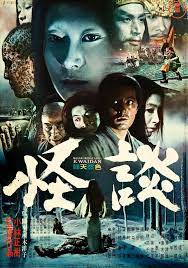
“The Black Hair”: When his Lord dies a swordsman finds himself poor. He decides to divorce his wife and work for another Lord to improve his status. He marries a woman with a higher social standing but is very selfish. He comes to realize that he is still in love with his first wife. Years later, when he leaves his second wife and tries to return to the woman he really loves he finds things are drastically different from when he left.
“The Woman of the Snow”: A woodcutter and his apprentice are caught in a snowstorm. They seek shelter in a boatman’s hut. During the night a spectral woman appears and takes the life out of the woodcutter. Seeing how young the apprentice is she takes pity on him and lets him live but she makes him promise to never tell anyone of the incident or she will kill him. That spring the young man meets a beautiful young woman. They fall in love and marry. Years later he tells his wife of the night in the boatman’s hut.
“Hoichi the Earless”: A battle was fought between the Taira and Minamoto clans. The final battle was called the Battle of Dan-no-ura. When the battle was over the one year old emperor and his escorts drown themselves rather than be killed by the enemy. Since then the stories of a ghost pervade the area. Hoichi is a blind story teller that is well versed in the Battle of Dan-no-ura. One night he is taken by a samurai to tell the story and play the Biwa for a lord of high rank. For several nights Hoichi is taken to tell another part of the complicated story. Not knowing what Hoichi is doing each night the head priest has him followed. The priest tells Hoichi that he has been telling the story to the dead and he is in great danger.
“In a Cup of Tea”: A writer relates a story about one of Lord Sado Nakagawa’s guards who saw the reflection of a man in a cup of tea. Throwing out the tea he got a fresh cup. Again he saw the image. He threw away the tea and broke the cup. Eventually he gives up and drinks the tea even with the reflection of the man staring at him. Later, while he is on guard the man appears. When the guard charges after him the man disappears. The next day the guard is at home. He is visited by three other ghosts. The guard battles the ghosts. They eventually disappear and the guard begins to show signs of madness. There the story stops but the writer is never able to finish the story.
“Kwaidan” was released in 1965. It is a Japanese horror anthology consisting of four stories and was directed by Masaki Kobayashi. The stories are a collection of folktales collected by Lafcadio Hearn. Kwaidan loosely translated means Ghost Story. Supposedly the four stories represent the four seasons of the year.
The film is a mix of impressionistic and minimalistic elements but is also vibrant with color. The simplistic sets add an interesting dimension to the stories. They incorporate psychological suspense and stylized images to express each story’s theme with sound being used as punctuation. It is a very visual film. The stories themselves are standard Japanese folktales but the way they are presented enhances each story. They are not horror stories so much as they are ghost stories. The only story with any blood in it is “Hoichi the Earless”.
The story “The Woman of the Snow” reminds me of the story in “Tales from the Dark Side: The Movie” 1990 called “Lover’s Vow” where an artist sees a gargoyle kill someone and promises never to tell anyone what he saw.
part 1 part 2

